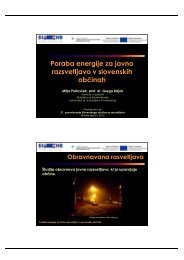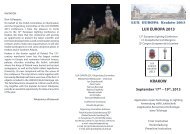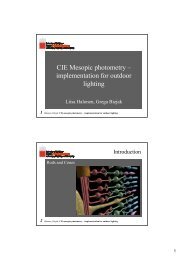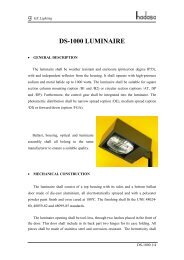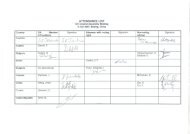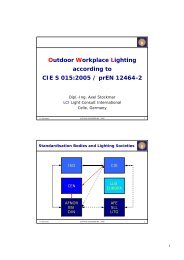Zbornik - SDR
Zbornik - SDR
Zbornik - SDR
Create successful ePaper yourself
Turn your PDF publications into a flip-book with our unique Google optimized e-Paper software.
“Colour rendering index of LED light sources” R-4<br />
Table 1: Light source characteristics used in the present experiment<br />
Description of<br />
light source<br />
Correlated<br />
colour<br />
temperature, K<br />
Ra<br />
CIE A 2856 100<br />
CIE D65 6505 100<br />
FL 3.5 4086 96<br />
FL 3.12 2984 93<br />
FlLamp 7226 87<br />
CIE FL 7 6497 86<br />
CIE FL 11 3999 83<br />
p-LED (cool) 9310 80<br />
p-LED (warm) 2976 77<br />
CIE FL 2 4225 64<br />
CIE FL 4 2938 51<br />
RGB-LED1 2788 44<br />
RGB-LED2 2788 27<br />
RGB-LED3 2788 -17<br />
In this new experimental paradigm the image of a scene was selected, where the spectral<br />
reflectance was known for every pixel. In the present experiment we used an image kindly supplied<br />
by Nascimento and co-workers 40 . Figure 8 shows the image rendered as it would look under D65<br />
illumination. The test images were calculated from this hyperspectral image, using the SPDs of the<br />
sources enumerated in Table 1.<br />
Figure 8: Image used in the present experiment.<br />
The white point of the generated test image is the white<br />
point of the test illuminant it was calculated under. The main<br />
concept of the simulation is that all images are shown in the<br />
same chromatic adaptation environment (CRT display) to<br />
eliminate factors such as colour memory effects that can<br />
affect the result of the experiments negatively. The<br />
CIECAM02 colour appearance model was used to transform<br />
both images (illuminated by the test and the reference<br />
illuminant) to D65, the white point of the monitor. This way<br />
the differences between the colour appearances produced by<br />
the test illuminants, independently of the CCT of the source<br />
could be observed and judged.<br />
7.1 Experiment<br />
In the experiment to be discussed here three images were shown simultaneously on the screen at<br />
one time in two rows. There were two images in the upper row and there was one in the middle of the<br />
lower row. The lower image was fixed and showed the reference image. The observers’ task was to<br />
“Lighting engineering 2006” stran 33



